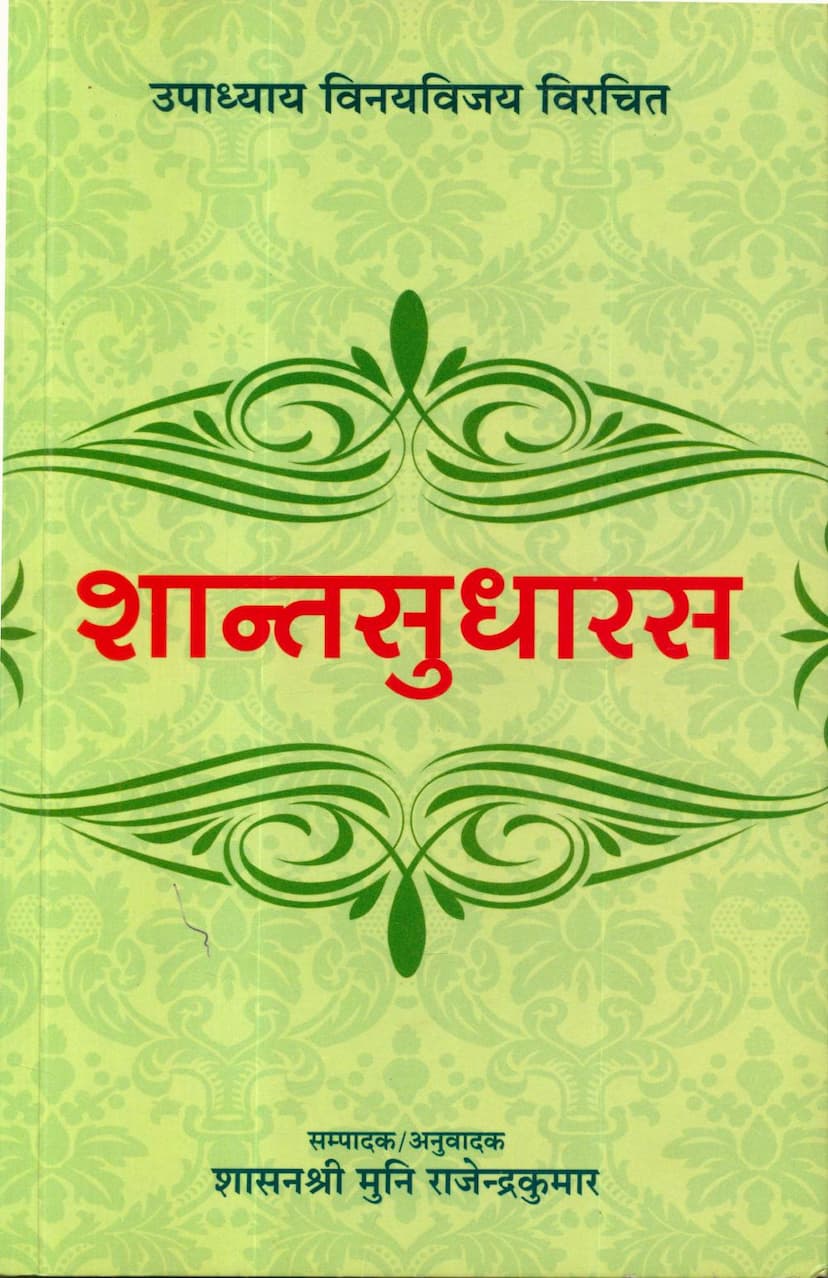Shant Sudharas
Added to library: September 2, 2025

Summary
Here's a comprehensive summary of the Jain text "Shant Sudharas" based on the provided information:
Book Title: Shant Sudharas (शान्तसुधारस) Author: Upadhyay Vinayavijay (उपाध्याय विनयविजय विरचित) Editor/Translator: Muni Rajendra Kumar (शासनश्री मुनि राजेन्द्रकुमार) Publisher: Adarsh Sahitya Sangh, New Delhi (आदर्श साहित्य संघ) Summary:
"Shant Sudharas" is a significant work of lyrical poetry in Sanskrit, composed by Upadhyay Vinayavijay, and meticulously edited and translated by Muni Rajendra Kumar. The book is a collection of sixteen "Anuprekshas" (अनुप्रेक्षा), which are profound meditations or contemplations central to Jain spiritual practice.
Core Concepts and Purpose:
- Anupreksha as a Spiritual Tool: The text emphasizes the crucial role of Anupreksha in Jain spiritual discipline. While "Preksha" (प्रेक्षा) is about knowing and seeing, "Anupreksha" (अनुप्रेक्षा) involves contemplation and reflection. The book argues that both contemplation (Savikalpa - सविकल्प) and non-contemplation (Nirvikalpa - निर्विकल्प) are essential for spiritual progress. The combination of Preksha and Anupreksha leads to complete fulfillment.
- Transformation of Inner States: The Anuprekshas presented in "Shant Sudharas" are described as foundational principles of Jain spiritual practice. Regular contemplation of these sixteen Anuprekshas helps to diminish lethargy and unconsciousness within the practitioner, leading to the attainment of truth.
- Addressing Emotional and Spiritual Ills: The book highlights the human condition as being afflicted by "Adhi, Vyadhi, and Upadhi" (आधि, व्याधि और उपाधि) – signifying mental, physical, and emotional distress. It posits that emotional unhealthiness is the root cause of human suffering. The Anuprekshas are presented as a form of spiritual therapy to address these deep-seated emotional issues.
- Spiritual Healing through Contemplation: The Anuprekshas are viewed as an "spiritual medical practice" (आध्यात्मिक चिकित्सा पद्धति) aimed at transforming life. By changing the "Bhavdhara" (भावधारा - stream of consciousness or emotional inclination), human conduct and behavior can be altered. The text draws a parallel to modern concepts like "brainwashing" and "suggestology" used in Western countries to change thought patterns, presenting Anupreksha as a Jain method of achieving the same through introspection.
- Unveiling Truth: Anupreksha is described as a means to reveal truth, to uncover the essence that is hidden beneath layers of ignorance and delusion. It's like clearing away the ashes to reveal the true flame of reality.
Content and Structure:
-
Sixteen Anuprekshas: The core of the book is the exposition of sixteen Anuprekshas. These are:
- Anitya Bhavana (अनित्य भावना - Impermanence)
- Asharan Bhavana (अशरण भावना - Lack of Refuge)
- Sansar Bhavana (संसार भावना - Cycle of Birth and Death)
- Ekatva Bhavana (एकत्व भावना - Solitude)
- Anyatva Bhavana (अन्यत्व भावना - Otherness)
- Ashauch Bhavana (अशौच भावना - Impurity)
- Asrav Bhavana (आस्रव भावना - Influx of Karmas)
- Samvar Bhavana (संवर भावना - Cessation of Influx)
- Nirjara Bhavana (निर्जरा भावना - Shedding of Karmas)
- Dharma Bhavana (धर्म भावना - Righteousness)
- Lok Bhavana (लोक भावना - The Universe)
- Bodhi Durlabha Bhavana (बोधिदुर्लभ भावना - Rarity of Enlightenment)
- Maitri Bhavana (मैत्री भावना - Friendship/Benevolence)
- Pramod Bhavana (प्रमोद भावना - Joy in others' Virtues)
- Karunya Bhavana (कारुण्य भावना - Compassion)
- Madhyasthya Bhavana (माध्यस्थ्य भावना - Equanimity/Neutrality)
The text notes that while twelve Anuprekshas are mentioned in early Jain Agamas, later literature, like the works of Ummaswati and Kundakundacharya, compiled them. The inclusion of Maitri, Pramod, Karunya, and Madhyasthya has roots in Yogic and Buddhist philosophies and appears in Jain literature in scattered forms, with their structured classification as Anuprekshas being a more recent development.
-
Lyrical and Devotional Nature: The book is presented as a "Geya Kavya" (गेय काव्य), a lyrical poem, woven into various Ragas and Raginis (राग-रागिनियों). This musical and poetic structure is intended to imbue the spiritual content with devotional essence, making it more engaging and emotionally resonant.
-
Editorial and Translation Contributions: Muni Rajendra Kumar's role as editor and translator is highlighted. He has not only translated the original Sanskrit work but also added illustrative stories ("Bhavanbodhak Kathayein" - भावनाबोधक कथाएं) that clarify the meaning of each contemplation, making the text accessible and understandable to a wider audience.
Testimonials and Editorial Forewords:
The book features blessings and endorsements from prominent Jain Acharyas:
- Acharya Tulsi (गणाधिपति तुलसी): He praises the work for its melodious and emotionally evocative nature. He acknowledges the effort in searching for the complete text and its memorization by numerous monks and nuns. He commends Muni Rajendra Kumar's translation for its depth and accessibility, incorporating explanatory stories.
- Yuvacharya Mahapragya (आचार्य महाप्रज्ञ): He emphasizes the importance of Anupreksha in Jain sadhana, linking it to the transformation of old samskaras. He discusses the traditional categorization of Anuprekshas related to Dharamdhyan and Shukladhyan and acknowledges the development of the sixteen Anuprekshas in "Shant Sudharas." He appreciates the "pranjal bhasha" (lucid language), "sashakt abhivyakti" (powerful expression), "bhav ki gambhirta" (depth of emotion), and "prasanna shaili" (pleasant style) of the work. He also shares insights into the textual corrections and modifications made during the translation process, highlighting the meticulous effort involved.
- Acharya Mahashraman (आचार्य महाश्रमण): He calls "Shant Sudharas" a beautiful work, particularly beneficial for Sanskrit students, and notes its potential to foster detachment and spiritual longing. He appreciates Muni Rajendra Kumar's translation for making it easily understandable and spiritually enriching.
Origin and Significance:
- Composition: The original work was composed in Sanskrit in 1723 Vikram Samvat (वि.सं. १७२३) at Gandhpura (गन्धपुर).
- Lineage: Upadhyay Vinayavijay was a disciple of Vachak Kirtivijay, who was himself a disciple of Hiravijayasuri.
- Widespread Practice: The text has gained significant popularity and is widely studied within the Terapanth Jain tradition.
In essence, "Shant Sudharas" is a profound spiritual guide presented in a beautiful lyrical format. It offers a systematic approach to inner transformation through the contemplation of sixteen core principles, aiming to alleviate suffering and lead the practitioner towards ultimate liberation and peace. The editorial and translational efforts have made this ancient wisdom accessible to contemporary seekers.